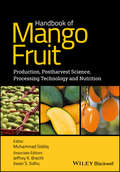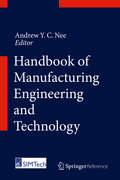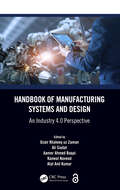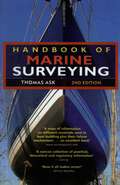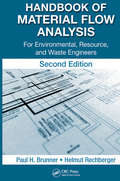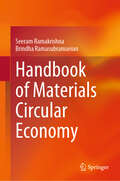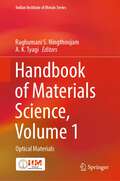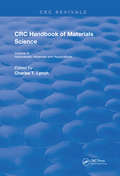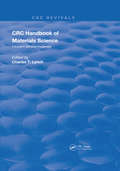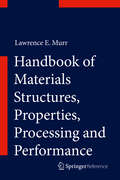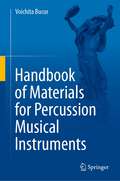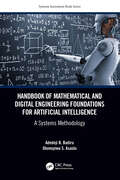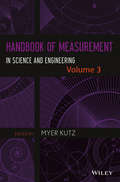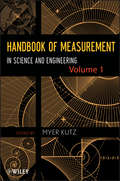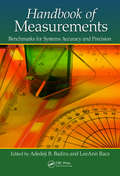- Table View
- List View
Handbook of Mango Fruit: Production, Postharvest Science, Processing Technology and Nutrition
by Muhammad Siddiq Jiwan S. Sidhu Jeffrey K. BrechtWritten by noted experts in the field, Handbook of Mango Fruit: Production, Postharvest Science, Processing Technology and Nutrition offers a comprehensive resource regarding the production, trade, and consumption of this popular tropical fruit. The authors review the geographic areas where the fruit is grown and harvested, including information on the ever-expanding global marketplace that highlights United States production, imports and exports, and consumption, as well as data on the outlook for the European market. Handbook of Mango Fruit outlines the postharvest handling and packaging techniques and reviews the fruit’s processed products and byproducts that are gleaned from the processing of waste. The authors include information on the nutritional profile of the mango and review the food safety considerations for processing and transport of mangoes. This comprehensive resource: Reviews global mango production trends and countries that are the major exporters and importers of mangoes Explores the burgeoning marketplace for mangoes with special emphasis on the US and European marketplace Assesses latest trends in packaging of and shipping of mangoes Provides in depth coverage on value-added processing and by-products utilization Offers vital information on the innovative processing technologies and nutritional profile of popular tropical fruit Written for anyone involved in the production, marketing, postharvest handling, processing and by-products of mangoes, Handbook of Mango Fruit is a vital resource offering the most current information and guidelines on the burgeoning marketplace as well as the safe handling, production, and distribution of mangoes.
Handbook of Manufacturing Control: Fundamentals, description, configuration
by Hermann Lödding Rett RossiUnternehmen mit kurzen Lieferzeiten, hoher Liefertreue und niedrigen Beständen wachsen schnell und erzielen hohe Gewinne. Wie Unternehmen diese logistische Herausforderung meistern können, zeigt das Buch anhand von aktuellen Forschungsergebnissen der Leibniz Universität Hannover. Der Band gibt einen umfassenden Überblick über die Aufgaben und Verfahren der Fertigungssteuerung und befähigt Leser dazu, Schwächen in diesem Bereich zu erkennen und zu korrigieren. Ein fundiertes Nachschlagewerk für Studierende, Dozenten, Ingenieure und Wissenschaftler.
Handbook of Manufacturing Engineering and Technology
by Andrew Y. C. NeeThe Springer Reference Work Handbook of Manufacturing Engineering and Technology provides overviews and in-depth and authoritative analyses on the basic and cutting-edge manufacturing technologies and sciences across a broad spectrum of areas. These topics are commonly encountered in industries as well as in academia. Manufacturing engineering curricula across universities are now essential topics covered in major universities worldwide.
Handbook of Manufacturing Systems and Design: An Industry 4.0 Perspective
by Ali Siadat Zaman, Uzair Khaleeq uz Aamer Ahmed Baqai Kanwal Naveed Atal Anil KumarThis book provides a comprehensive overview of manufacturing systems, their role in product/process design, and their interconnection with an Industry 4.0 perspective, especially related to design, manufacturing, and operations. Handbook of Manufacturing Systems and Design: An Industry 4.0 Perspective provides the knowledge related to the theories and concepts of Industry 4.0. It focuses on the different types of manufacturing systems in Industry 4.0 along with associated design, and control strategies. It concentrates on the operations in Industry 4.0 with a particular focus on supply chain, logistics, risk management, and reverse engineering perspectives. Offering basic concepts and applications through to advanced topics, the handbook feeds into the goal of being a source of knowledge as well as a vehicle to explore the future possibilities of design, techniques, methods, and operations associated with Industry 4.0. Concepts with practical applications in the form of case studies are added to each chapter to round out the many attributes this handbook offers. This handbook targets students, engineers, managers, designers, and manufacturers, and will assist in their understanding of the core concepts of manufacturing systems in connection with Industry 4.0 and optimize alignment between supply and demand in real time for effective implementation of the design concepts.
Handbook of Marine Surveying
by Thomas AskThis expanded and updated edition of Thomas Ask&’s Handbook of Marine Surveying will be welcomed by students of marine surveying, professional marine surveyors, boatyard operators and technically-minded boat owners. It covers the latest surveying technology, including an analysis of the mechanical behavior of materials, stress concentration, failure analysis, fatigue an fracture, corrosion, wood-damaging organisms, the composition and characteristics of common plastics, metals and composite materials.New sections include: hull and deck loads, non-destructive testing, combustion and pollution, hydraulic and pneumatic systems, engine installations, fuel systems, electrical systems, piping and lubrication systems, HVAC/R systems, firefighting systems, noise and vibration, and propellers.There is also a useful survey checklist that provides practical techniques and hints for conducting a survey.
Handbook of Material Engineering in Nanobiomedicine and Diagnostics
by Pranjal Chandra Uday Pratap AzadThe book is about the application of nanotechnology in the field of medicine, with a focus on diagnosis and therapy. The first few chapters introduce the basics of material engineering and nanobiomedicine, followed by chapters on different types of engineered nanomaterials and their surface modification strategies for biomedicine. The book then covers the application of nanobiomedicines and nanodiagnostics in clinical settings, and how functionalized nanomaterials can be used in microfluidic biosensors and diagnosis devices. The latter half of the book discusses various nanobiomaterials used in cancer diagnosis and therapy, as well as regenerative medicine, infectious diseases, and bioimaging. The book concludes with a chapter on the commercial aspects of nanobiomedicines.
Handbook of Material Flow Analysis: For Environmental, Resource, and Waste Engineers, Second Edition (Advanced Methods In Resource And Waste Management Ser.)
by Paul H. Brunner Helmut RechbergerIn this second edition of a bestseller, authors Paul H. Brunner and Helmut Rechberger guide professional newcomers as well as experienced engineers and scientists towards mastering the art of material flow analysis (MFA) from the very beginning to an advanced state of material balances of complex systems. Handbook of Material Flow Analysis: For Environmental, Resource, and Waste Engineers, Second Edition serves as a concise and reproducible methodology as well as a basis for analysis, assessment and improvement of anthropogenic systems through an approach that is helpfully uniform and standardized. The methodology featured in this book is a vital resource for generating new data, fostering understanding, and increasing knowledge to benefit the growing MFA community working in the fields of industrial ecology, resource management, waste management, and environmental protection. This new second edition takes into account all new developments and readers will profit from a new exploration of STAN software, newly added citations, and thoroughly described case studies that reveal the potential of MFA to solve industrial ecology challenges.
Handbook of Materials Circular Economy
by Seeram Ramakrishna Brindha RamasubramanianThis book provides comprehensive and practical information on the design and implementation of circular systems for various industries, with a focus on Environmental, Social, and Governance (ESG) factors. The scope of the handbook is to cover the materials circularity in a deeper analysis in accordance to ESG used in various industries such as oil and gas, IT, electronics, medicine, textile, and more. The handbook also covers the key principles of the circular economy, including material efficiency, resource conservation, and waste reduction, and how they impact to different industries. It further critically analyses the challenges and opportunities associated with implementing circular systems in these industries, including the framework for new business models and technical innovations, and the potential benefits in terms of environmental protection, social responsibility, and economic competitiveness. In addition to providing practical information, the handbookalso addresses the ESG factors associated with the circular economy exclusively for each industry. This would include the impact of circular systems on the environment, including the reduction of greenhouse gas emissions and the protection of biodiversity, as well as the social benefits, such as job creation, and the economic benefits, such as cost savings and increased competitiveness. The ultimate goal of the handbook should be to provide guidance and support in a niche evaluation for the development of a more sustainable and equitable future, where the circular economy is a key enabler.
Handbook of Materials Science, Volume 1: Optical Materials (Indian Institute of Metals Series)
by A. K. Tyagi Raghumani S. NingthoujamThis book presents the state-of-the-art coverage of optical materials and their application in various areas. The contents range from basic principles to quantum cutting luminescent materials, advances in plasmonic and photonic substrate-coupled fluorescence, lanthanide doped materials for optical applications, thermoluminescence and optical material for sensing radioactive elements. It also discusses synthesis, characterization and properties of optical materials including nanomaterials, luminescent nanomaterials for anti-counterfeiting, carbon materials-based nanoscale optics and plasmonics, optoelectronics applications of two dimensional materials and applications of lanthanide ion-doped phosphors. This book is of immense value to those in academia and industry working in the areas of material science, especially optical materials.
Handbook of Materials Science, Volume 2: Magnetic Materials (Indian Institute of Metals Series)
by A. K. Tyagi Raghumani S. NingthoujamThis book presents state-of-the-art coverage of the basic concepts of magnetization. The book focuses on electron-spin interaction, electron-spin-magnetic field interactions with or without angular dependent, magnetic properties with the dimension of particles or surrounding environment, proximity effects on core-shell structure or hybrid or composite and their applications. It also discusses recent advances in magnetic materials and its future scope. This book is of interest to students, researchers and professionals working in the area of materials science, especially magnetic materials and allied fields.
Handbook of Materials Science: Nonmetallic Materials & Applications (Routledge Revivals #3)
by Charles T. LynchPublished in 1974: The CRC Handbook of Materials Science provides a current and readily accessible guide to the physical properties of solid state and structural materials.
Handbook of Materials Science: Volume 1 General Properties (Routledge Revivals #1)
by Charles T. LynchPublished in 1974: The CRC Handbook of Materials Science provides a current and readily accessible guide to the physical properties of solid state and structural materials.
Handbook of Materials Selection for Engineering Applications
by G. T. MurrayReflecting the rapid advances in new materials development, this work offers up-to-date information on the properties and applications of various classes of metals, polymers, ceramics and composites. It aims to simplify the materials selection process and show how to lower materials and manufacturing costs, drawing on such sources as vendor supplie
Handbook of Materials Structures, Properties, Processing and Performance
by Lawrence E. MurrThis extensive knowledge base provides a coherent description of advanced topics in materials science and engineering with an interdisciplinary/multidisciplinary approach. The book incorporates a historical account of critical developments and the evolution of materials fundamentals, providing an important perspective for materials innovations, including advances in processing, selection, characterization, and service life prediction. It includes the perspectives of materials chemistry, materials physics, engineering design, and biological materials as these relate to crystals, crystal defects, and natural and biological materials hierarchies, from the atomic and molecular to the macroscopic, and emphasizing natural and man-made composites. This expansive presentation of topics explores interrelationships among properties, processing, and synthesis (historic and contemporary). The book serves as both an authoritative reference and roadmap of advanced materials concepts for practitioners, graduate-level students, and faculty coming from a range of disciplines.
Handbook of Materials for Percussion Musical Instruments
by Voichita BucurThis book describes the properties of materials used for making percussion instruments for classical music played by a symphony orchestra in which the instruments could be played as a soloist instrument or as a group or several groups of instruments, as they are included into a musical work. A chapter is devoted to the bells. The scope of this book is primarily confined to percussion instruments of symphony orchestras taking into account the centuries of musical art and tradition. This book bridges the gap in the technical literature on describing the properties of materials for percussion instruments—timpani, other drums, marimba, xylophone, vibraphone, gong, cymbal, triangle, celesta, castanets.
Handbook of Mathematical Methods in Imaging
by Otmar ScherzerThe Handbook of Mathematical Methods in Imaging provides a comprehensive treatment of the mathematical techniques used in imaging science. The material is grouped into two central themes, namely, Inverse Problems (Algorithmic Reconstruction) and Signal and Image Processing. Each section within the themes covers applications (modeling), mathematics, numerical methods (using a case example) and open questions. Written by experts in the area, the presentation is mathematically rigorous. The entries are cross-referenced for easy navigation through connected topics. Available in both print and electronic forms, the handbook is enhanced by more than 150 illustrations and an extended bibliography. It will benefit students, scientists and researchers in applied mathematics. Engineers and computer scientists working in imaging will also find this handbook useful.
Handbook of Mathematical Techniques for Wave/Structure Interactions
by C.M. Linton P. McIverAlthough a wide range of mathematical techniques can apply to solving problems involving the interaction of waves with structures, few texts discuss those techniques within that context-most often they are presented without reference to any applications. Handbook of Mathematical Techniques for Wave/Structure Interactions brings together some of the
Handbook of Mathematical and Digital Engineering Foundations for Artificial Intelligence: A Systems Methodology (Systems Innovation Book Series)
by Adedeji B. Badiru Olumuyiwa AsaoluArtificial intelligence (AI) and digital engineering have become prevalent in business, industry, government, and academia. However, the workforce still has a lot to learn on how to leverage them. This handbook presents the preparatory and operational foundations for the efficacy, applicability, risk, and how to take advantage of these tools and techniques. Handbook of Mathematical and Digital Engineering Foundations for Artificial Intelligence: A Systems Methodology provides a guide for using digital engineering platforms for advancing AI applications. The book discusses an interface of education and research in the pursuit of AI developments and highlights the facilitation of advanced education through AI and digital engineering systems. It presents an integration of soft and hard skills in developing and using AI and offers a rigorous systems approach to understanding and using AI. This handbook will be the go-to resource for practitioners and students on applying systems methodology to the body of knowledge of understanding, embracing, and using digital engineering tools and techniques. The recent developments and emergence of Chatbots (AI tools) all have mathematical foundations for their efficacy. Such AI tools include ChatGPT, GPT-4, Bard, Tidio Support Bot, Kuki AI Companion, Meena, BlenderBot, Rose AI Chatbot, Replika: AI Friend, Eviebot, and Tay. This handbook highlights the importance of mathematical and digital foundations for AI developments. The handbook will enhance the understanding and appreciation of readers about the prevailing wave of artificial intelligence products, and, thereby, fitting the current market needs.
Handbook of Mathematics and Statistics for the Environment
by Frank R. Spellman Nancy E. WhitingA thorough revision of the previous "Environmental Engineer's Mathematics Handbook," this book offers readers an unusual approach to presenting environmental math concepts, emphasizing the relationship between the principles in natural processes and environmental processes. It integrates the fundamental math operations performed by environmental pr
Handbook of Mathematics for Engineers and Scientists (ISSN)
by Andrei D. Polyanin Alexander V. ManzhirovCovering the main fields of mathematics, this handbook focuses on the methods used for obtaining solutions of various classes of mathematical equations that underlie the mathematical modeling of numerous phenomena and processes in science and technology. The authors describe formulas, methods, equations, and solutions that are frequently used in scientific and engineering applications and present classical as well as newer solution methods for various mathematical equations. The book supplies numerous examples, graphs, figures, and diagrams and contains many results in tabular form, including finite sums and series and exact solutions of differential, integral, and functional equations.
Handbook of Measurement in Science and Engineering, Volume 1
by Myer KutzEncyclopedic in scope, this volume is a multidisciplinary reference of engineering measurement tools, techniques, and applications. Whether engineers are attempting to state requirements quantitatively and demonstrate compliance, to track progress and predict results, or to analyze costs and benefits, they must use the right tools and techniques to produce meaningful, useful data. This volume covers civil and environmental engineering, mechanical and biomedical engineering, and industrial engineering and is the most comprehensive, up-to-date reference set on engineering measurements beyond anything on the market today.
Handbook of Measurement in Science and Engineering, Volume 1
by Myer KutzA multidisciplinary reference of engineering measurement tools, techniques, and applications—Volume 1 "When you can measure what you are speaking about, and express it in numbers, you know something about it; but when you cannot measure it, when you cannot express it in numbers, your knowledge is of a meager and unsatisfactory kind; it may be the beginning of knowledge, but you have scarcely in your thoughts advanced to the stage of science." — Lord Kelvin Measurement falls at the heart of any engineering discipline and job function. Whether engineers are attempting to state requirements quantitatively and demonstrate compliance; to track progress and predict results; or to analyze costs and benefits, they must use the right tools and techniques to produce meaningful, useful data. The Handbook of Measurement in Science and Engineering is the most comprehensive, up-to-date reference set on engineering measurements—beyond anything on the market today. Encyclopedic in scope, Volume 1 spans several disciplines—Civil and Environmental Engineering, Mechanical and Biomedical Engineering, and Industrial Engineering—and covers: New Measurement Techniques in Structural Health Monitoring Traffic Congestion Management Measurements in Environmental Engineering Dimensions, Surfaces, and Their Measurement Luminescent Method for Pressure Measurement Vibration Measurement Temperature Measurement Force Measurement Heat Transfer Measurements for Non-Boiling Two-Phase Flow Solar Energy Measurements Human Movement Measurements Physiological Flow Measurements GIS and Computer Mapping Seismic Testing of Highway Bridges Hydrology Measurements Mobile Source Emissions Testing Mass Properties Measurement Resistive Strain Measurement Devices Acoustics Measurements Pressure and Velocity Measurements Heat Flux Measurement Wind Energy Measurements Flow Measurement Statistical Quality Control Industrial Energy Efficiency Industrial Waste Auditing Vital for engineers, scientists, and technical managers in industry and government, Handbook of Measurement in Science and Engineering will also prove ideal for members of major engineering associations and academics and researchers at universities and laboratories.
Handbook of Measurement in Science and Engineering, Volume 2
by Myer KutzA multidisciplinary reference of engineering measurement tools, techniques, and applications—Volume 2 "When you can measure what you are speaking about, and express it in numbers, you know something about it; but when you cannot measure it, when you cannot express it in numbers, your knowledge is of a meager and unsatisfactory kind; it may be the beginning of knowledge, but you have scarcely in your thoughts advanced to the stage of science." — Lord Kelvin Measurement falls at the heart of any engineering discipline and job function. Whether engineers are attempting to state requirements quantitatively and demonstrate compliance; to track progress and predict results; or to analyze costs and benefits, they must use the right tools and techniques to produce meaningful, useful data. The Handbook of Measurement in Science and Engineering is the most comprehensive, up-to-date reference set on engineering measurements—beyond anything on the market today. Encyclopedic in scope, Volume 2 spans several disciplines—Materials Properties and Testing, Instrumentation, and Measurement Standards—and covers: Viscosity Measurement Corrosion Monitoring Thermal Conductivity of Engineering Materials Optical Methods for the Measurement of Thermal Conductivity Properties of Metals and Alloys Electrical Properties of Polymers Testing of Metallic Materials Testing and Instrumental Analysis for Plastics Processing Analytical Tools for Estimation of ParticulateComposite Material Properties Input and Output Characteristics Measurement Standards and Accuracy Tribology Measurements Surface Properties Measurement Plastics Testing Mechanical Properties of Polymers Nondestructive Inspection Ceramics Testing Instrument Statics Signal Processing Bridge Transducers Units and Standards Measurement Uncertainty Data Acquisition and Display Systems Vital for engineers, scientists, and technical managers in industry and government, Handbook of Measurement in Science and Engineering will also prove ideal for members of major engineering associations and academics and researchers at universities and laboratories.
Handbook of Measurements: Benchmarks for Systems Accuracy and Precision (Systems Innovation Book Series)
by Adedeji B. Badiru LeeAnn RaczPlanning, measuring, and paying attention to details form the basis for all successful engineering operations. Measurements pervade everything we do and must be viewed from a systems perspective. A comprehensive all-encompassing guide to measurements, Handbook of Measurements: Benchmarks for Systems Accuracy and Precision focuses on high-level engineering computations essential for benchmarks and technical innovation. The book uses a systems framework and a technically rigorous approach to systems linking of measurements—an approach that sets it apart from other handbooks.The popular saying "measure twice and cut once" bears out the importance of measurements in human endeavors. This handbook covers both qualitative and quantitative topics of measurement. It opens with a chapter on the fundamentals of measurement and includes coverage of human-centric measurements, such as measurement of personnel productivity and contractor performance. It concludes with three appendices on measurement, references, conversion factors, equations, formulas, and statistics for measurement.It is well understood that humans cannot manage anything that cannot be measured. All elements involved in our day-to-day decision making involve some form of measurement, whether in the kitchen, retail, sports, service operations, geographical exploration, health care delivery, worker productivity, clothing design, engineering product design, or space craft launching. Measuring an attribute of a system and then analyzing it against some standard, some specification, some best practice, or some benchmark empower a decision maker to take appropriate and timely actions. This book gives you a guide for sustainable practices to ensure accurate measurements, helping you make decisions backed by metrics.
Handbook of Meat and Meat Processing
by Y. H. HuiRetitled to reflect expansion of coverage from the first edition, Handbook of Meat and Meat Processing, Second Edition, contains a complete update of materials and nearly twice the number of chapters. Divided into seven parts, the book covers the entire range of issues related to meat and meat processing, from nutrients to techniques for preservati
